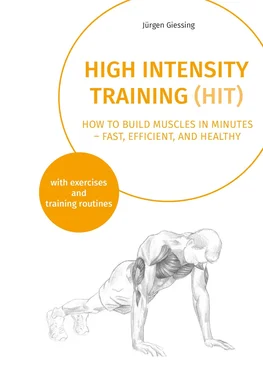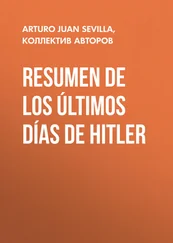Jürgen Giessing
High Intensity Training
High Intensity Training
How to build muscles in minutes – fast, efficient, and healthy
by
Jürgen Giessing
Imprint:
© 2016 Copyright by Jürgen Gießing
Druck: epubli, a service of neopubli GmbH, Berlin
What this book is about
How many sets should be performed for optimal progress? How many repetitions per set for maximal muscle growth? How many training days per week are best? Which exercises are recommended? Split training or even double split training? How many warm-up sets? Heavy or light weight? Strict exercise form or cheating?
There are so many questions concerning training that it is not surprising that many people are confused. Looking at each of these questions may actually contribute to neglecting another question that is not only more important but also the base for all answers to these individual questions. And this question is:
How does training work?
Training processes have been studied for many years using the most recent scientific methods available. The relevance of training parameters (for muscle stimulation) as well as the importance of rest (for regeneration) have been identified in detail and provide us with all the information necessary to make the body adapt in the desired way to build up lean muscle.
This book is about how training works and what this means if the goal is to gain lean muscle. As a sports science professor I often come across misconceptions of training that have been disproved long ago but are still being passed on. One of these misleading concepts is the “the more, the better” approach that is still followed by millions of trainees world-wide. However, sports science has proven many times that the quality of training is much more important than its quantity. This book deals with the reasons for this “lie that will not die” and how current findings of sports science can be used to one’s advantage. Making the quality of training a priority has the pleasant “side-effect” that the quantity of workouts can be reduced. In fact, it even has to, if quality is the top priority.
If you want to know more about the theoretical background and practical implications for training, read on.
Table of Contents
1 Survival of the fittest? How much and what kind of exercise our body needs
2 How training works
3 Intensity of effort
4 The discovery of High Intensity Training
5 The (missing) scientific background of multiple-set training
6 The Holy Trinity: All good things come in threes
7 The paradigm shift that never happened
8 The essence of High Intensity Training
9 Training programs
9.1 Sample full-body workout A
9.2 Sample full-body workout B
9.3 Sample full-body workout C
9.4 Sample full body workout with pre-exhaustion A
9.5 Sample full body workout with pre-exhaustion B
9.6 Sample full body workout with post-exhaustion A
9.7 Sample full body workout with post-exhaustion B
9.8 Split program: Sample upper/lower body split
9.9 Split program: Sample upper/lower body split with pre-exhaustion
9.10 Split program: Sample upper/lower body split with post-exhaustion
9.11 Split program: Push-pull split A (two-way split)
9.12 Split program: Push-pull split B (three-way split)
10 Intensity and consistency
List of Figures
Figure 1:... Lack of physical exercise causes negative adaptation and regression. 12
Figure 2:... Milo of Croton. 21
Figure 3:... Improved muscle fiber activation precedes muscular hypertrophy. 26
Figure 4:... The General Adaptation Syndrome (GAS). 32
Figure 5:... Friedrich Nietzsche. 33
Figure 6:... The process of supercompensation. 34
Figure 7:... The training threshold. 37
Figure 8:... Arthur Jones. 44
Figure 9:... Cross referencing by physiologists who recommend the execution of multiple sets (Carpinelli, 2002, p. 320). 55
Figure 10:. Strength gains after ten weeks of HIT compared to ten weeks of three-set training. 60
Figure 11:. Mike Mentzer. 83
Figure 12:. Drop set: reducing the resistance immediately after reaching muscular failure. 99
Figure 13:. Leg press. 109
Figure 14:. Back row.. 112
Figure 15:. Shrug. 114
Figure 16:. Pec-deck fly. 116
Figure 17:. Incline bench press. 116
Figure 18:. Leg extension. 118
Figure 19:. Squat 118
Figure 20:. Lat pull-down. 120
Figure 21:. Pullover. 120
Figure 22:. Dips. 122
Figure 23:. Push-up. 122
Figure 24:. Leg curl 124
Figure 25:. Shoulder press. 126
Figure 26:. Leg extension. 128
Figure 27:. Leg press. 128
Figure 28:. Biceps curl 130
Figure 29:. Leg curl 132
Figure 30:. Calf raise. 132
Figure 31:. Dumbbell lateral raise. 134
Figure 32:. Chin-up. 136
Figure 33:. Incline dumbbell press. 138
Figure 34:. Back row.. 140
Figure 35:. Abdominal crunch. 142
Figure 36:. Incline bench press. 144
The images in Figure 1 and 2 were created by Udo Buffler. Julia Suchoroschenko created the image on the front cover, the images in Figure 3, 4, 6, and 7 and all portraits and illustrations of training exercises in this book (Fig. 5, Fig. 8, and Fig. 11-36).
List of Tables
Table 1:.. Intensity of effort: the four degrees. 41
Table 2:.. Studies that found no significant difference in strength gains as a result of performing a greater number of sets (Carpinelli, 2002, p. 322). 61
1 Survival of the fittest ? How much and what kind of exercise our body needs
For thousands of years adapting to the demands of one’ s environment and living conditions was the best one could do in order to survive. Those best suited to their environment and its particular demands on physical activity had the greatest chances of survival (and of passing on their genes). For thousands of years being the fittest meant being able-bodied and powerful. It meant coping with an environment by covering large distances every day looking for water and food, collecting whatever could be eaten, hunting and killing prey while avoiding being eaten at the same time. Therefore, those who were fast, strong and enduring were the fittest and had the best chances of surviving.
Today things are different. They have changed tremendously and are almost reversed. Those who best fit to their environment will not walk for miles each day. They are more likely to work in a factory or an office, carry a notebook instead of a spear and a meal-to-go instead of the prey they have hunted. They use contemporary methods of transportation like cars, taxis, planes, trains, busses, and the underground, which require almost zero physical activity from the passenger while travelling from one place to another. And this kind of modern, effortless transportation is not limited to roads and streets. It is also available within buildings. For example, there are elevators, escalators, assembly lines and other devices that transport items or people. Basically, hardly any physical activity is needed to be well-equipped for our modern world.
For the contemporary consumer food does not have to be picked from trees, much less hunted, killed and skinned. It is available in all kinds of variations from all around the world and in all seasons. Some kinds of food, especially fast food, are available 365 days a year 24/7 and can be ordered by a mouse click (which is physical activity, too, but not exactly intense) or a phone call and are delivered to our door step if we wish so. Instead of having to follow our prey for miles to finally hunt it down with intense effort, all we have to do is get up from the armchair and walk to the front door where we receive the ready-to-eat food. In terms of physical activity we have come a long way (or rather just the opposite) from what our ancestors had to do in order to survive.
Читать дальше












